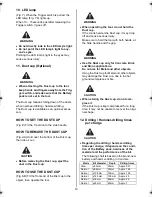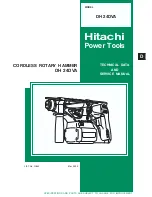
7
parts.
Damaged or entangled cords in-
crease the risk of electric shock.
•
When operating a power tool outdoors,
use an extension cord suitable for out-
door use.
Use of a cord suitable for out-
door use reduces the risk of electric shock.
•
Do not use the power tool in the rain,
where water is splashing, in a wet
place, or in a damp place.
Using the tool
in these or similar conditions will increase
the risk of electric shock, dangerous mal-
function, and overheating.
If operating a
power tool in a damp location is una-
voidable, use a residual current device
(RCD) protected supply.
Use of an RCD
reduces the risk of electric shock.
3. PERSONAL SAFETY
•
Stay alert, watch what you are doing and
use common sense when operating a
power tool. Do not use a power tool while
you are tired or under the influence of
drugs, alcohol or medication.
A moment
of inattention while operating power tools
may result in serious personal injury.
•
Use personal protective equipment.
Always wear eye protection.
Protective
equipment such as dust mask, non-skid
safety shoes, hard hat, or hearing protec-
tion, hand protector used for appropriate
conditions will reduce personal injuries.
•
Prevent unintentional starting. Ensure
the switch is in the off-position before
connecting to power source and/or
battery pack, picking up or carrying
the tool.
Carrying power tools with your
finger on the switch or energizing power
tools that have the switch on invites acci-
dents.
•
Remove any adjusting key or wrench
before turning the power tool on.
A wrench or a key left attached to a rotat-
ing part of the power tool may result in a
personal injury.
•
Do not overreach. Keep proper footing
and balance at all times.
This enables
better control of the power tool in unex-
pected situations.
•
Dress properly. Do not wear loose
clothing or jewellery.
Keep your hair,
clothing and gloves away from moving
parts. Loose clothes, jewellery or long hair
can be caught in moving parts.
•
If devices are provided for the connec-
tion of dust extraction and collection
facilities, ensure these are connected
and properly used.
Use of dust collec-
tion can reduce dust-related hazards.
4. POWER TOOL USE AND CARE
•
Do not force the power tool. Use the
correct power tool for your applica-
tion.
The correct power tool will do the job
better and safer at the rate for which it
was designed.
•
Do not use the power tool if the switch
does not turn it on and off.
Any power
tool that cannot be controlled with the
switch is dangerous and must be re-
paired.
•
Disconnect the plug from the power
source and/or the battery pack from
the power tool before making any ad-
justments, changing accessories, or
storing power tools.
Such preventive
safety measures reduce the risk of start-
ing the power tool accidentally.
•
Store idle power tools out of the reach
of children and do not allow persons
unfamiliar with the power tool or these
instructions to operate the power tool.
Power tools are dangerous in the hands
of untrained users.
•
Maintain power tools. Check for mis-
alignment or binding of moving parts,
breakage of parts and any other condi-
tion that may affect the power tool's
operation. If damaged, have the power
PJR265_CE.book 7 ページ 2010年10月13日 水曜日 午後4時51分








































